How Does ANPR Play Its Role In Crime Prevention In UK?

Automatic Number Plate Recognition (ANPR) technology has become an essential tool in the fight against crime in the UK. The system allows cameras to capture images of vehicle registration plates and cross-reference them with databases of stolen, untaxed, and uninsured vehicles and drivers with outstanding warrants or driving offences. Law enforcement agencies, parking enforcement authorities, and private organizations widely use this technology.
3d number plates Manchester can significantly improve the accuracy and reliability of ANPR technology, making it an even more valuable tool in the fight against crime.
In this article, we will explore how ANPR plays its role in crime prevention in the UK.
Introduction:
The UK has one of the largest ANPR networks in the world, with an estimated 10,000 cameras installed across the country. The technology has proven to be a valuable tool in preventing and detecting criminal activity, improving road safety, and reducing traffic congestion. ANPR cameras can capture vehicle registration plates from up to 100 feet, and the images can be processed in real time, providing instant alerts to law enforcement agencies.
ANPR in Crime Prevention
This technology is used extensively in crime prevention, particularly in identifying and tracking stolen vehicles. The police use ANPR cameras to monitor major roads, highways, and other public areas, intending to identify stolen vehicles and capture the suspects. ANPR cameras can quickly identify stolen vehicles by matching the registration plate number with the database of stolen vehicles maintained by the Police National Computer (PNC). This database is updated in real-time, which means that the police can quickly respond to any alerts and apprehend suspects before they have a chance to escape.
ANPR also monitors and tracks suspects in serious crimes such as robbery, burglary, and murder. When a crime is committed, ANPR cameras can capture the registration plate number of the suspect’s vehicle, which can then be used to track their movements and identify their location. This technology has proven to be a valuable tool in solving complex crimes and apprehending suspects quickly.
ANPR in Traffic Enforcement
This technology is also widely used in traffic enforcement, particularly in enforcing road tax and insurance laws. ANPR cameras can identify vehicles that are not taxed or insured, and the images can be cross-referenced with offenders’ databases. This technology has proven to be an effective deterrent, encouraging drivers to comply with the law and reducing the number of uninsured and untaxed vehicles on the road.
ANPR is also used to enforce parking regulations, particularly in busy urban areas. ANPR cameras can capture the registration plate number of vehicles parked in restricted areas, and the images can be used to issue fines and penalties. This technology has proven to be an effective tool in reducing traffic congestion and improving road safety.
ANPR in Counter-Terrorism
This technology plays a crucial role in counter-terrorism efforts in the UK. ANPR cameras are used to monitor major roads, highways, and other public areas to identify suspicious vehicles and potential terrorist activity. The technology is used with other surveillance measures, such as CCTV cameras and human intelligence, to provide a comprehensive and effective counter-terrorism strategy.
ANPR in Criminal Investigations
ANPR technology has proven to be a valuable tool in criminal investigations, particularly in identifying and tracking suspects’ movements. For example, ANPR cameras can be used to track the movements of a suspect vehicle before and after a crime is committed. The data collected from ANPR cameras can be used as court evidence, helping secure convictions and bring criminals to justice.
ANPR Limitations
Despite its many benefits, ANPR technology does have limitations. One of the main concerns is privacy, as ANPR cameras capture images of all vehicles passing by, not just those involved in criminal activity. There are also concerns about data protection, as the images captured by ANPR cameras are stored in databases that law enforcement agencies and other organizations can access.
There is also the risk of false positives, where ANPR cameras may incorrectly identify a vehicle as involved in criminal activity. This can lead to innocent individuals being wrongly accused, and their privacy violated. To mitigate these risks, it is essential to have proper oversight and regulation of ANPR systems and robust data protection measures in place.